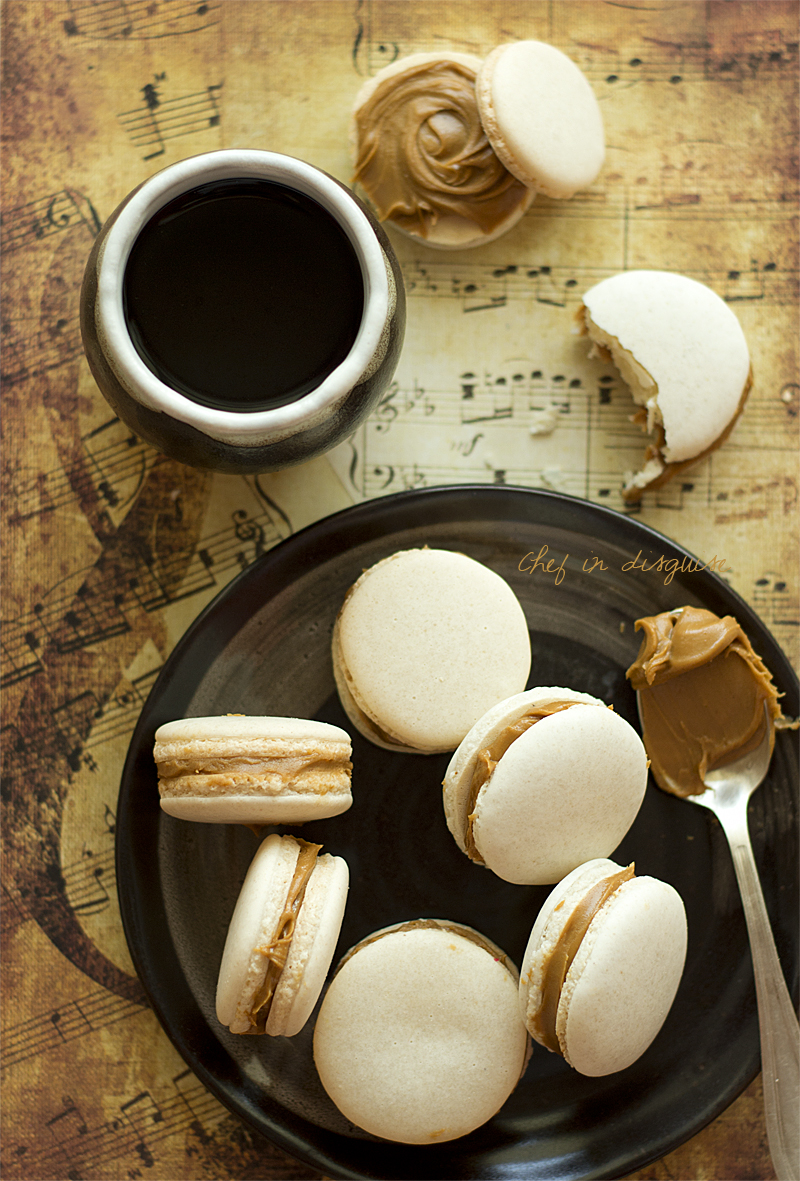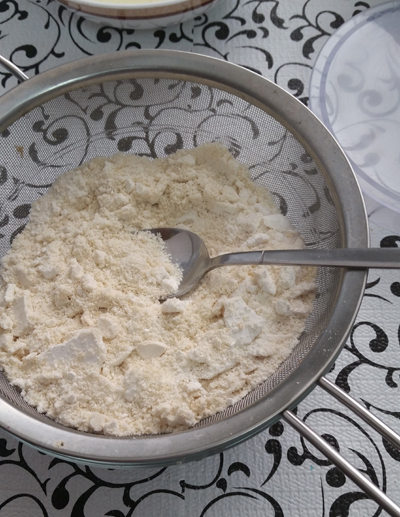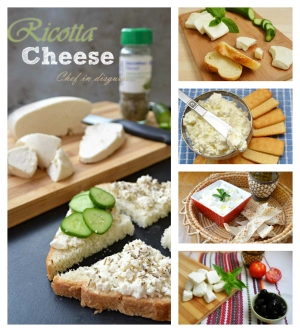For the month of October we got to take on one of many bakers’ deepest, darkest kitchen nightmares : macarons. Our talented bakers Korena from Korena in the Kitchen and Rachael from pizzarossa made the intimidating task of mastering these French beauties a breeze
Raise your hand if Macarons intimidate you or if you have tried making them and failed miserably more than once.
Can I raise my hand 3 times?
Yup! I have tried and failed horribly 3 times. My macarons spread, they cracked and were too flat but with every failed attempt I have learnt something and perfected my technique and finally, success!

There are two schools of thought when it comes to macaron shells, which are made from a batter of ground almonds and powdered (confectioner’s) sugar folded into meringue. The first is to use a French meringue (a basic meringue where sugar is gradually beaten into egg whites) and the second is to use an Italian meringue (where a hot sugar syrup is drizzled into whipping egg whites).
Since all my previous attempts have been using the French method it was time to try something new
I am highlighting important notes in red through out the recipe, please pay extra attention to these as they will help you in your macaron making adventure 🙂

Macaron shells using the Italian meringue method
Servings: 30 x 4cm / 1 1/2” filled macarons
Ingredients
(original recipe in grams)
140g / 4.9 oz ground almonds, room temperature
140g / 4.9 oz powdered (confectioner’s) sugar
100g / 3.5 oz egg white (from approx. 3 eggs), room temperature, divided 50/50
100g / 3.5 oz granulated (white) sugar
40g / 1.4 oz (weight) water
Optional:
Replace 20g / .7 oz of the powdered sugar with unsweetened cocoa powder or powdered freeze dried fruit
The seeds of 1 vanilla bean
A few drops of non-oil-based essence
A few drops of gel food colouring or a pinch of powder food colouring
Directions:
Prepare 2 parchment (not wax paper) lined baking sheets. They need to be big enough to hold 30 x 4cm / 1 1/2” diameter shells each.
It helps to place a piping guide under the parchment. You can print any of these two guides if you like
Printable macaron piping template
Printable macaron piping template 2
Mix the ground almonds and powdered sugar together in a bowl, then grind in a food processor until you have an extra fine texture. You may need to do this in batches, depending on the size of your food processor.

Sift into a large bowl , putting any bigger pieces of almond back into the food processor to re-grind.


Add 50g egg whites and mix thoroughly into the almond mixture. At this point, you can add food colouring or flavouring such as vanilla seeds, citrus zest, essense, if desired.

In another bowl, or the bowl of a stand mixer, scrupulously clean and free of any oil or egg yolk, beat the other 50g egg whites to stiff peaks.

Meanwhile, put the granulated sugar and water into a small heavy-based saucepan and heat on medium-low to 118°C / 244°F, without stirring.
While whisking constantly on low speed (to avoid splashing hot syrup), slowly add the cooked sugar mixture to the beaten egg whites, pouring it down the inside edge of the bowl. You’ll get a bit of it hardening on the side of the bowl, but that’s okay – just leave it there.

Whisk at high speed until the mixture is cool, about 3 minutes. About 1 minute before the end, you can add food colouring, if not done at the almond paste stage. The mixture should increase in volume and become firm and shiny, and it should be thick and marshmallowy when you lift the whisk.It may take you much longer than three minutes to get to that consistency, just keep whisking until the volume increases and you get firm stiff peaks that are shiny
Scrape the meringue onto the almond mixture and incorporate with a rubber or silicone spatula. You do actually want to get some of the air out of the mixture – you do this by folding and squashing the mixture against the side of the bowl, rotating the bowl a quarter turn with each fold. Be sure to firmly scrape the bottom of the bowl with the spatula, so you don’t leave a layer of almond paste there.
Mix until you have a homogenous batter that runs from the spatula in a thick ribbon (at first when it will fall off the spatula in chunks, then with more mixing it turns into a thick ribbon) and it takes about 30 seconds for it to fade back into the mix
Mixing is a critical step, over mixing will result in flat macaroons that crack on top, undermixing will result in macarons with no feet. The key is to reach the stage when the batter falls off the spatula when you raise it in a thick ribbon and takes about 30 seconds to fade into the mix
Transfer the mixture into a piping bag fitted with a 7 – 9mm / #10 – #12 plain round tip (this is best done in two batches, so you don’t overfill the bag). Pipe 60 equally sized rounds, about 4cm / 1 1/2” in diameter, in staggered rows onto the prepared sheets. Hold the piping bag upright with the tip just above the sheet and pipe without pulling upwards or swirling in circles, so the batter comes out in a round blob around the tip, and give a little sideways flick at the end to break the stream.
Tap the baking sheet firmly on the bench several times to release air bubbles and obtain a smooth surface. If you have any tips sticking up, press them gently down with a damp fingertip.
Leave the tray to rest at room temperature for at least 20 minutes until a slight skin forms. If you touch it, it should be only just tacky.
Meanwhile, preheat oven to 150°C / 300°F / Gas Mark 2.
Bake the macarons in the centre of the oven for 18 minutes (20 minutes if using cocoa in the shells), one sheet at a time, turning the sheet half-way.
Remove from oven and remove the parchment from the tray with the shells still on it and place on a cooling racks for at least 30 minutes, until completely cool, then remove macaron shells carefully from the parchment.
If not filling straight away, store in an airtight container at room temperature, separating layers with parchment. Otherwise, fill and store in an airtight container in the fridge to mature for at least 24 hours before eating.

I filled my macarons with biscoff . It was much easier to fill them the next day as opposed to the day when they were baked
Storage & Freezing Instructions/Tips:
Macaron shells should be stored in an airtight container at room temperature. While best eaten the day after making, filled macarons will keep in an airtight container in the fridge for up to a week, depending on the filling. They may be frozen for several months, depending on the filling. Defrost for about 30 minutes.
Additional Information:
The original macaron recipe is in grams because macarons rely on specific ratios of almonds to powdered sugar to meringue, I recommend using weight rather than volume measurements, which are much less accurate
Regarding almonds – you can use ground almonds with or without the skins on,it all comes down to the final look, if you don’t mind little specks of brown, you can use skin on.
If you can’t buy ground almonds locally, you can grind them yourself. Just don’t use an almond flour which is very fine and powdery – ground almonds are gritty when rubbed between your fingers. You will grind them further with the powdered sugar. Almonds can be substituted for other nuts or seeds, however their oil content can change the way the batter behaves, so it’s probably best to use almonds on your first try, and then play around once you’re confident in your macaron skills.
Some thoughts on food colouring… Whether you use it or not is entirely up to you, but if you do use it, what you use will determine how much you use and the method you use will determine when you add it. You should only use gel or powder – avoid liquid food colouring, as it can add too much moisture to the mix.
Baking the macaron shells: some bakers use a double or triple stack of baking sheets to help insulate the macaron shells as they bake. This might be a useful technique if your oven runs hot or heats unevenly.




















